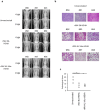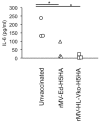Efficacy of recombinant measles virus expressing highly pathogenic avian influenza virus (HPAIV) antigen against HPAIV infection in monkeys
- PMID: 28931922
- PMCID: PMC5607339
- DOI: 10.1038/s41598-017-08326-x
Efficacy of recombinant measles virus expressing highly pathogenic avian influenza virus (HPAIV) antigen against HPAIV infection in monkeys
Abstract
Highly pathogenic avian influenza virus (HPAIV) is a serious threat not only to domestic fowls but also to humans. Vaccines inducing long-lasting immunity against HPAIV are required. In the present study, we generated recombinant measles virus (MV) expressing the hemagglutinin protein of HPAIV without the multibasic site necessary for its pathogenicity in chickens using the backbone of an MV vaccine strain (rMV-Ed-H5HA) or a wild-type MV-derived mutant (rMV-HL-Vko-H5HA). We examined protective efficacy of the candidate vaccines in the monkey infection model by the challenge with a HPAIV (H5N1). Cynomolgus monkeys inoculated with the candidate vaccines produced both anti-H5 HA and anti-MV antibodies. They recovered earlier from influenza symptoms than unvaccinated monkeys after the challenge with the HPAIV strain. Chest radiography and histopathological analyses confirmed less severe pneumonia in the vaccinated monkeys. Vaccination tended to suppress viral shedding and reduced the interleukin-6 levels in the lungs. Furthermore, the vaccination with rMV-Ed-H5HA of monkeys with pre-existing anti-MV immunity induced the production of anti-H5 HA antibodies. These results suggest that both candidate vaccines effectively reduce disease severity in naïve hosts, and that rMV-Ed-H5HA is a particularly good candidate vaccine against HPAIV infection.
Conflict of interest statement
The authors declare that they have no competing interests.
Figures





Similar articles
-
Protection of chickens against H5N1 highly pathogenic avian influenza virus infection by live vaccination with infectious laryngotracheitis virus recombinants expressing H5 hemagglutinin and N1 neuraminidase.Vaccine. 2009 Jan 29;27(5):773-85. doi: 10.1016/j.vaccine.2008.11.033. Epub 2008 Nov 28. Vaccine. 2009. PMID: 19041677
-
Protective efficacy of Newcastle disease virus expressing soluble trimeric hemagglutinin against highly pathogenic H5N1 influenza in chickens and mice.PLoS One. 2012;7(8):e44447. doi: 10.1371/journal.pone.0044447. Epub 2012 Aug 28. PLoS One. 2012. PMID: 22952980 Free PMC article.
-
Protection against H5N1 highly pathogenic avian and pandemic (H1N1) 2009 influenza virus infection in cynomolgus monkeys by an inactivated H5N1 whole particle vaccine.PLoS One. 2013 Dec 23;8(12):e82740. doi: 10.1371/journal.pone.0082740. eCollection 2013. PLoS One. 2013. PMID: 24376571 Free PMC article.
-
Measles studies in the macaque model.Curr Top Microbiol Immunol. 2009;330:55-72. doi: 10.1007/978-3-540-70617-5_3. Curr Top Microbiol Immunol. 2009. PMID: 19203104 Free PMC article. Review.
-
Reverse genetics of measles virus and resulting multivalent recombinant vaccines: applications of recombinant measles viruses.Curr Top Microbiol Immunol. 2009;329:129-62. doi: 10.1007/978-3-540-70523-9_7. Curr Top Microbiol Immunol. 2009. PMID: 19198565 Free PMC article. Review.
Cited by
-
Recombinant Measles AIK-C Vaccine Strain Expressing Influenza HA Protein.Vaccines (Basel). 2020 Mar 27;8(2):149. doi: 10.3390/vaccines8020149. Vaccines (Basel). 2020. PMID: 32230902 Free PMC article.
-
Recombinant SLAMblind Measles Virus Is a Promising Candidate for Nectin-4-Positive Triple Negative Breast Cancer Therapy.Mol Ther Oncolytics. 2020 Sep 30;19:127-135. doi: 10.1016/j.omto.2020.09.007. eCollection 2020 Dec 16. Mol Ther Oncolytics. 2020. PMID: 33145396 Free PMC article.
-
Versatility of live-attenuated measles viruses as platform technology for recombinant vaccines.NPJ Vaccines. 2022 Oct 15;7(1):119. doi: 10.1038/s41541-022-00543-4. NPJ Vaccines. 2022. PMID: 36243743 Free PMC article. Review.
-
Self-replicating vehicles based on negative strand RNA viruses.Cancer Gene Ther. 2023 Jun;30(6):771-784. doi: 10.1038/s41417-022-00436-7. Epub 2022 Feb 15. Cancer Gene Ther. 2023. PMID: 35169298 Free PMC article. Review.
-
A protective measles virus-derived vaccine inducing long-lasting immune responses against influenza A virus H7N9.NPJ Vaccines. 2023 Mar 24;8(1):46. doi: 10.1038/s41541-023-00643-9. NPJ Vaccines. 2023. PMID: 36964176 Free PMC article.
References
Publication types
MeSH terms
Substances
LinkOut - more resources
Full Text Sources
Other Literature Sources
Medical

